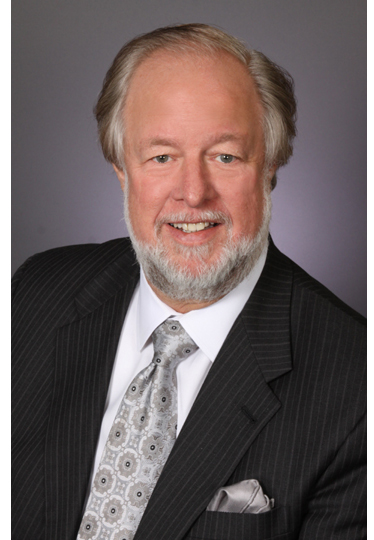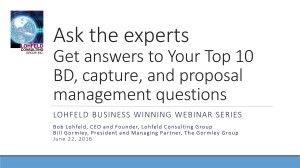Q&A Part 5: General questions – BD, Capture, and Proposals
Watch the webinar replay and listen to the podcast (MP3)
 Recently, Bob Lohfeld, CEO, Lohfeld Consulting Group and Bill Gormley, President and Managing Partner, The Gormley Group discussed various challenges faced by BD, capture, and proposal professionals supporting Federal Government contractors.
Recently, Bob Lohfeld, CEO, Lohfeld Consulting Group and Bill Gormley, President and Managing Partner, The Gormley Group discussed various challenges faced by BD, capture, and proposal professionals supporting Federal Government contractors.
Read the Q&A, watch the webcast, or listen to the podcast to find out how to help your company work smarter and reinvent what you’re doing to remain competitive in today’s GovCon market.
Question: What is your outlook on the market and the upcoming election?
Bill: On the election standpoint, regardless of who wins party-wise, from a government contractor budget impact, it’s pretty much going to be negligible. There’s not going to be any change. And the reason I’m saying that is because the budget for next year is already being worked right now. So whoever steps into the White House and takes over control of the government from a leadership standpoint, they have a budget that they’re going to have to stay with through 2017. It’s really going to be 12, maybe 18 months, before you really see any swing if there is going to be a swing. It would be by exception that you would see any drastic changes from a government-addressable market standpoint.
Bob: Let me put a little fine-tuning to that. In my experience, we’re coming up on the end of an 8-year term of a president, so no matter what happens going forward, many of the political appointees in government agencies will be changed out. The leadership in government agencies—the politicals—realize that they have between now and the first of October to implement changes that they want to make, or maybe between now and the first of December. I often see at the end of an 8-year stretch renewed emphasis on buying and obligating money—and then that’s the influx of transactions. We get a slowdown come the new election, the new president, the new appointments of politicals, and we hit a trough in the spending. So I think it’s a little bit of an up wave and a little bit of a down wave on top of the 2017 budget.
Bill: I think this is not going to be a surprise to anyone, there’s a high probability of a continuing resolution (CR). What the CR equates to from an addressable market standpoint is the government is going to buy at the level next year that it was buying at this year, which is October 1. Whatever it takes to run the government—that’s always going to be out there and being acquired—so that’s not going to go away. It’s anything new, and getting to your point, Bob, if someone in a particular agency or a senior official says, “Hey! I’m going to get this program off the ground,” you may see an RFP out or an RFI on it trying to get it launched beforehand. You can look for those, but I think those are going to be few and far between.
Bob: How many shopping days left in the year for the government?
Bill: Never enough!
Question: With the shift in government procurement regarding category management, LPTA, and IT consolidation, traditional price-to-win approaches can prove inadequate. How do firms adapt their pricing strategies to compensate, remain competitive, and profitable?
Bill: Well we’re rolling up here a lot of what we talked about today, so we’re not going to be any miracle workers in one sit-down session. A lot of it’s going to be recognizing the way the government market is going. To Bob’s several points he’s raised, you need to be in step with it. You need to understand it. And, don’t continue to fall back on past practices. So, it depends on how you’re buying and how you’re handling your HR resources internally or how you’re managing your company—it has to change. But, that should not be news to anybody.
Bob: I think you have to know your customer as they differ in terms of their sensitivity to price. Some agencies will tell you, “We want best value. We want technical superiority.” Then they turn around and award to the lowest price from the offerors time and time again. You have to separate the talk from the walk. That will help you set strategy. At the vehicle level, be fair and reasonable about it—about pricing—because the price evaluation is not so sensitive at a vehicle level, but the shootout is at the task order, and you have to know your customer and know what you need to do.
Question: What is the main focus of capture and how do you start the process?
Bob: Capture has two purposes. One is to get you ready to write the best proposal that you could possibly write. You start that out by getting together the smart people in your company, forming a capture team, and then getting deeply involved understanding this customer and this requirement. If you understand it better than anyone else, you’ll create a better solution than anyone else. So that’s where capture begins. The other part of it is to get the government prepared to award to you. I’ve always had this belief that we don’t do business with people we don’t know—or at least we try not to—and I think people in government share that. So during capture you have a chance to make yourself visible and make yourself credible as a player. Raise the expectation within government that you’re going to provide this service or product that they want.
Bill: Basically, you’re aligning to capture to align your internal resources and then also to be able to convey that to the government as to how well prepared you are to meet their requirements.
Bob: And if you do that overall, you raise your win probability. If you don’t do capture, well, your probability of win wasn’t raised.
Bill: Yes. The day of walking in and brand name recognition—I’m not saying it still doesn’t have credibility today based on past performance—but I think other folks who are coming in with, from their viewpoint, more agile offerings are getting more attention today.
Bob: Yes. I would agree.
Question: What is the ideal win rate percentage? Too high, not bidding enough or stretching—or too low, bidding the wrong or too many RFPs?
Bill: This is a great question. There’s no answer to it, number one. So let’s start with that. But number two, the reason that there’s no answer to it is in talking to some companies, I’ll ask them what their win rate is. They’ll say, “80%” and I’ll respond, “80%! I’m surprised you aren’t just building in the whole square block downtown! But let me understand something. How did you get the 80%?” And they’ll answer, “Bill, it’s a little secret. We’re very, very selective on what we go for.”
Bob: I wrote a paper on this in Washington Technology where the same question was posed, and I said if you’re winning 80%, then you’re not bidding enough. Open the aperture on what you’re going to bid because you will be better off by bidding more, dropping your win rate, but you’ll increase your revenue and you’ll increase your return on investment. If you’re down in the 20%, you’re in the mud, and you’ve got some things that are really wrong in your business and probably without looking at your business, you’re not doing a good job qualifying deals and you’re chasing stuff you shouldn’t chase. Second reason will be you’re pretending to execute capture and you’re not doing it. Instead of capture, you’re tracking. Third reason is you’re writing mediocre proposals one after another. All of those can be diagnosed and corrected within companies. We see a lot of companies run along at 50% or 60%, and I’d say that’s really at a sweet spot. They’re writing well, they’re picking deals, and they’re delivering value to their shareholders.
Question: How do you introduce innovation to your customer when you’re currently performing for them and you’re coming up for recompete?
Bill: On the innovation side, there’s a lot out there where the government wants to be innovative, wants to attract innovation, wants to be agile—you hear all these words more and more. I think a key here—and it’s a balancing act—is that the sight to go agile does not align with oversight, because the oversight folks are not agile and they get a little nervous. They’re looking at structure on the oversight and that’s from a procurement standpoint. They have people who are always looking over them seeing how well they’re doing. So, to get to the question, how do you offer up [innovation] and be considered, I think it really boils down now to the relationship you have with that customer and in a nice way conveying how you’re being restricted from being more agile and making that customer better. So that’s a dicey area, but it should be pursued because the government is out there saying, “We want to tap into Silicon Valley. We want to be more agile.” And obviously we’re seen recent things in the press about where people have tried to be agile getting criticism, so some of that’s going to go on. So I think if you have a contact in the agency who’s willing to listen to you and consider it and give you the opportunity, then you should actually pursue that.
Bob: One of the steps in capture is testing your solution with the customer to the extent you can. Here we want to validate our assumptions and test the water with some innovative ideas. I’ve had customers say to us when we’ve done this, “Well, we like two of the three ideas. The third one—we tried that before and we’ll never go there again.” That’s the kind of insight you need to know. Your innovation can be very scary to a customer that’s not ready to have you come in and change how they do business. So, test it. Be cautious about it. But work hard to come up with it.
Watch the webinar replay and listen to the podcast (MP3)
Listen to the podcast on your PC (MP3):
Alternative content
Click to listen to the podcast on your tablet/phone (MP3)
During the webinar, Bob referenced a number of articles to assist government contractors:
- 7 questions to answer when making bid/no-bid decisions (improve your win rates)
- Win rates double with seven quality measures – updated (Lohfeld seven quality measures)
- DoD revamps source selection process
- DoD releases new Source Selection Procedures
Our experts:
 Bob Lohfeld, CEO and Founder, Lohfeld Consulting Group
Bob Lohfeld, CEO and Founder, Lohfeld Consulting Group
Bob Lohfeld serves as CEO and general manager of Lohfeld Consulting Group. He has more than 30 years’ experience winning contracts in the government market and is recognized consistently for leadership in business development, capture management, and winning proposals development. He teaches Capture Management, and he writes the Capture Management column in Washington Technology.
Prior to forming Lohfeld Consulting Group, Bob served as Division President at Lockheed Martin, Vice President of Lockheed Martin Information Technology, Senior Vice President at OAO Corp., Systems Engineering Manager at Computer Sciences Corp. (CSC), and Program Manager at Fairchild Industries. He also taught at the graduate level at George Washington University School of Engineering Administration.
Bob has served on the Board of Directors for the Association of Proposal Management Professionals (APMP) and Association of Proposal Management Professional National Capital Area Chapter (APMP-NCA), as Chairman of the American Council on Technology Industry Advisory Council (ACT/IAC), Vice Chairman of the Technology Council of Maryland (TCM), and Board Member of the Armed Forces Communications and Electronics Association (AFCEA), Government Electronics and Information Association (GEIA), and Juvenile Diabetes Research Foundation (JDRF Capital Region). He is a three-time winner of Federal Computer Week’s Federal 100.
Bill Gormley, President and Managing Partner, The Gormley Group
Bill Gormley is a 40-year veteran of government procurement. He spent 28 years at the GSA in positions ranging from procurement agent to Senior Executive (SES) Assistant Commissioner for the Office of Acquisition. He was responsible for acquisition policy and all contracting operations, which included the Federal Supply Schedules Program. Bill’s extensive experience re-engineering the GSA Multiple Award Schedules Program earned him recognition by both government and industry. While serving as Assistant Commissioner for the Office of Acquisition at GSA, Bill received both the Presidential Rank Award for Meritorious Executives and the Vice President’s “Hammer Award” for changes to the Federal Supply Schedules Program. He was twice named to the Federal Computer Week Federal 100 awards—a prestigious group nominated by their peers for outstanding contributions to industry and government.
Bill left GSA to become President of the Washington Management Group (WMG). Shortly after joining WMG he purchased FedSources, a leading market intelligence firm for federal spending, and spent the next 11 years running both companies as President and CEO until both were acquired in 2011 by Deltek, Inc.
In addition to Bill’s role as President and Managing Partner of The Gormley Group, Bill serves as Chairman of The Coalition for Government Procurement and Vice Chair of the Procurement Roundtable. He is a lifetime member of the National Institute for Government Purchasing (NIGP). Bill has contributed to the publication of two books related to the GSA Schedules Program and is recognized for his GSA Schedules domain expertise.
Paperback or Kindle
10 steps to creating high-scoring proposals
by Bob Lohfeld
contributors Edited by Beth Wingate
Subscribe to our free ebrief
Teaming friends, frenemies, and enemies—12 tips to mitigate harmful effects
Did you know that contracting officers spend up to 20% of their time mitigating disputes between teaming partners? In an informal poll we conducted on LinkedIn last month, 40% of respondents classified their teaming partners as “frenemies” on their last bid.
Explore Further
- Advice (445)
- AI (5)
- APMP (17)
- Business Development (197)
- Capture Management (196)
- Favorite Books (5)
- Go-to-Market (27)
- Graphics (6)
- Lohfeld Books (3)
- Past Performance (58)
- Post-submission Phase (15)
- Pre-RFP Preparation (210)
- Proposal Management (269)
- Proposal Production (60)
- Proposal Reviews (27)
- Proposal Writing (77)
- Pursuit Phase (89)
- Research Report (2)
- Resources (60)
- Tools & Tips (258)
- Training (10)
- Uncategorized (220)

Sign Up for INSIGHTS and Download your FREE book
We'd love to help you with your proposals. Enjoy our complimentary Lohfeld Consulting Group Capture & Proposal Insights & Tips book with your FREE subscription to our Insights Newsletter.
GET YOUR FREE BOOK






